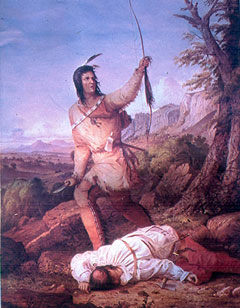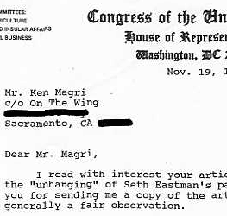
Was "Death
Whoop" Scalped from the Halls of Congress?
Re-edited from an article originally published in On The Wing in
1987

In a move designed with the best
intentions, a painting was recently removed from the U.S. Capitol Building that
now raises questions about censorship. Death
Whoop, an 1869 painting of a victorious Indian holding his victim's scalp,
was unceremoniously unhung from the hearing room of the House Interior
Committee. The October 8th removal came at the urging of Representative
Ben Nighthorse Campbell, a first term Democrat and only Native American in
Congress. According to an
Associated Press article, Campbell called
Death Whoop "a depressing painting" that was "out of touch
with the sensitivity of Indians."
Campbell's main objection
concerned what he viewed as a negative stereotype of Indians engaged in
violence. "It plays on the
prejudice of man" he told the AP, saying the painting was "out of
feeling with the rest of the Capitol. I
don't see any pictures of the internment of Japanese Americans in World War II,
or the slavery of Blacks." Campbell
felt Death Whoop was especially
offensive in a room where all legislation dealing with Indians is handled.
He also challenged the painting's accuracy, stating that the Indian's
garb was that of an Eastern woodlands tribe, but had sashes decorated with
Plains Indians designs.
Death Whoop was painted by retired General Seth Eastman as one of
nine works commissioned in 1867 by the Interior Secretary.
Eastman, who learned to paint at the U.S. Military Academy, did hundreds
of renderings of Indian life. That
includes about 300 illustrations in the 1850s for H.R. Schoolcraft's monumental
six-volume book Indian Tribes of the United States. More than any other
19th century painter of Indians, Eastman was a stickler for accuracy.
Relying on several decades of firsthand observations in the South and
Midwest, and as commander at Fort Snelling in Minnesota, he prided himself on
making authentic, unprejudiced recordings of Indian lifestyles.
It was quite common for other
painters to overdramatize scenes, too often concentrating on themes of violence
for a ready and waiting public on the East Coast. Even George Catlin, perhaps the best known painter in this
genre, staged some of his scenes for added flair, and frequently lacked the
attention to detail for which Eastman was so highly regarded. In his biography on Eastman, John Francis McDermott wrote
that the artist's importance came from an objective point of view:
"In serious interest in his aboriginal subjects, in detachment of
personal feeling, in devotion to the historian's purpose, he stands apart from
such painters as Charles Deas, Alfred Jacob Miller, George Catlin, and the Swiss
artist Carl Bodmer."
In a phone conversation with
Representative Campbell's press secretary Carol Knight, I raised the question of
censorship. Knight responded
"That simply wasn't the intent here. Congressman
Campbell has said to several reporters who asked the question that the picture
could hang whenever they're doing a show of Eastman's work, for example, or in a
context like that…but it's a murderous, bloody picture that he doesn't
appreciate looking at day in and day out."
Regarding Campbell's charge of inaccuracy Knight told me "he has
probably 50 books on Indian designs and symbolic renditions, so I think
Congressman Campbell might be considered an expert on that."
I also spoke with Barbara
Wolanin, curator to the Architect of the Capitol, the office that oversees all
works in the U.S. Capitol collection. Wolanin
agreed that Eastman did accurate portrayals, but in his later years he might
have "mixed up" details such as costuming.
She felt most of the criticism was coming from the fact that Death
Whoop has a somewhat posed nature that dramatized the actual event.
But admittedly she was not an expert on Eastman and seemed reluctant to
get further involved in the controversy.
Campbell was also disturbed by
the misconception that Indians exclusively practiced scalping, saying they
probably learned it from the French and that it only occurred in isolated
situations. While it's true that
scalping was not widely practiced, the Sioux (or Dahcotah) Indians commonly
performed scalp dances in which squaws surrounded a scalp stretched across a
ring and held up by a pole.
Was it fair for Eastman to
portray a scalping? McDermott wrote
that the artist paid "relatively little attention" to Indian warfare,
and that Death Whoop was the only
battle scene he ever painted. When
themes of violence did show up in Eastman's gallery it was "not because
they display the martial spirit, but because they were commonplaces of
experience."
It is ironic that a man's
reputation can be tainted because of a single painting, especially a man whose
primary motive seemed to be historical rendition. Every text I found on Eastman praised his accuracy and
absence of personal bias. In Painting
in America E.P. Richardson separated Eastman from others he called
"glorifiers and dramatizers." McDermott
wrote "He had sympathy towards the Indian who was being crowded out by
time, but never let his sympathy draw him into sentimentality; he never prettied
up the Indian to please a distant, romantic-minded public.
For Eastman the Indian was not a debased creature or a noble primitive or
an element in frontier adventure, but a man with customs of his own."
Carol Knight made it clear that Campbell was not seeking publicity by advocating the removal of Death Whoop. "We were going about it in a quiet manner," she told me. "We just wanted the thing removed. The word got out and it seemed to capture people's attention. I can certainly understand your sensitivity to the issue, and the paintings are all beautiful in an artistic sense." Although she felt my questions were appropriate, Knight held fast to the congressman's assertion that Death Whoop had no business hanging in the Interior Committee's hearing room.
-Ken Magri
After this article
appeared in print, I sent Rep. Campbell a copy. Here is his reply:
